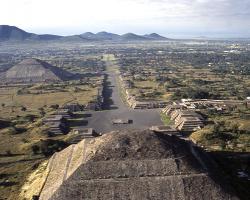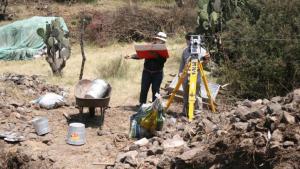
Plaza of the Columns Complex
This project seeks to understand what kind of government ruled Teotihuacan, and how the urban center developed there. By studying the Plaza of the Columns and the Plaza North of the Sun Pyramid and analyzing archaeological materials from these areas, researchers are gaining insight into the political and economic atmosphere of the ancient city.
The details of this multi-institutional effort were sourced from the project’s team page at the Plaza of the Columns Complex website. Check it out for more facts and photos!
Project Details
The Plaza of the Columns and the Plaza North of the Sun Pyramid (collectively, the Plaza of the Columns Complex) are some of the least-studied administrative structures along the Avenue of the Dead. Written accounts from surveys during the late 19th and early 20th centuries suggest that important political or religious officials may have once lived at the two plazas.
To begin this project’s survey of the Plaza of the Columns Complex, archaeologists created a 3D map of the site by taking topographic measurements of its features during the 2015 and 2016 field seasons. The team also used remote sensing methods such as magnetic survey, geoelectrical survey and ground-penetrating radar to help determine what lay under the ground and, accordingly, the best areas to excavate.
Four areas, Fronts A - D, were excavated in the 2015 season, with Front E opening in 2016 and Front F scheduled to begin in 2017. During excavation, archaeologists recorded each object found within the 46 quadrants, as well as its context. Recovered materials, such as ceramics, bones, soil samples and plant remains, were then taken to a lab where they were curated and analyzed.
Research Team
- Verónica Ortega Cabrera, Director of Front A, Instituto Nacional de Antropología e Historia
- Saburo Sugiyama, Director of Front B, Arizona State University
- Nawa Sugiyama, Director of Front C, George Mason University
- William Flash, Director of Front D, Harvard University
- David Carballo, Director of Front E, Boston University
Funding
- Instituto Nacional de Antropología e Historia, Mexico
- National Science Foundation, U.S.A.
- Japan Society for the Promotion of Science, Japan
- Santander Program for Research and Conservation of Sculpture, Harvard University
Outcomes
Results of the 2015 season
Archaeologists not only recovered a great deal of artifacts and materials during this season, but also uncovered many architectural elements. Discovery highlights include:
- Construction cells used to elevate and level floors
- Steps along the Avenue of the Dead and the main staircase of a primary structure at the Plaza of the Columns Complex
- Entire walls, stucco fragments, and room blocks painted red
- Various floors with postholes, multiple construction layers and signs of being burned
- Carved stones with red paint still remaining
- A drainage channel leading to a canal
- A structure with two (and possibly more) room blocks

